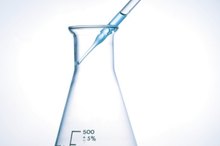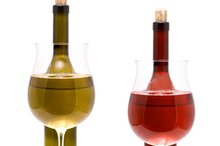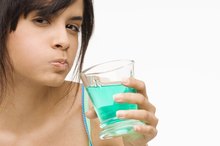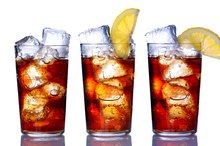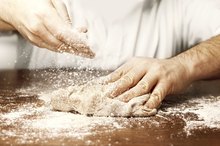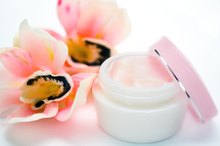Types of Citric Acid
Citric acid is not to be confused with vitamin C. It is a weak organic acid found in various fruits and vegetables. Citric acid is also found in the metabolism in every form of life and is part of the citric acid cycle. It can be used as a preservative, flavoring in drinks and as an organic cleaning solvent. The type of citric acid you purchase will depend on the intended use of the product.
Food Grade Citric Acid
Citric acid is a common food additive. Food grade citric acid is water soluble and used in flavoring a variety of food and beverages. It comes in powder or pill form. It is used to enhance tart flavors in candies, soft drinks and gelatins. It also balances PH in foods, according to the European Citric Acid Manufacturers Association, or ECAMA 2. PH adjustment is used in pectin for gelling and to set gelatins. It is used in wine to prevent ferric turbidity, metals forming in the oxidation process.
Citric acid is a major flavor enhancer for lemon, lime or other citrus soft drinks. It enhances the tangy fruit flavors in these drinks. It also helps keeps the acidic consistency in fruit cordials and juices.
In canned foods, citric acid helps to maintain the color, consistency and appearance of the food.
- Citric acid is a common food additive.
- Citric acid is a major flavor enhancer for lemon, lime or other citrus soft drinks.
Pharmaceutical Citric Acid
The Sources of Malic Acid
Learn More
Citric acid in salt or liquid form is used in pharmaceuticals, personal care products and cosmetics. Citrate salt can be used with bicarbonate and made into a bath bomb or bath fizzy.
Citric acid used in cosmeceuticals is found in alpha hydroxy acid creams that are used to exfoliate the skin and promote healing, according to the New Zealand Dermatological Society. The citric acid in alpha hydroxy lotion and creams is from lemons and limes or other fruits containing citric acid.
It is also used in cosmetics as a preservative and for improving stability of the product, according to the ECAMA.
- Citric acid in salt or liquid form is used in pharmaceuticals, personal care products and cosmetics.
- Citric acid used in cosmeceuticals is found in alpha hydroxy acid creams that are used to exfoliate the skin and promote healing, according to the New Zealand Dermatological Society.
Citric Acid Solvents
Citric acid is an antimicrobial pesticide and used as a sanitizer, germicide, disinfectant and virucide, according to the Environmental Protection Agency. It is safe for use on kitchen counter tops, changing tables, around pets and for a fruit or vegetable wash.
Citric acid can be used instead of phosphates in detergents and industrial cleaners. This helps to lower the amount of phosphates, which are environmental pollutants, that are introduced into rivers and lakes. Citric acid is biodegradable and does not pollute the environment.
The Food and Drug Agency has approved citric acid for use as a food additive and for use around food. It is considered an environmental risk factor for terrestrial or aquatic life, according to the Environmental Protection Agency.
- Citric acid is an antimicrobial pesticide and used as a sanitizer, germicide, disinfectant and virucide, according to the Environmental Protection Agency.
- Citric acid can be used instead of phosphates in detergents and industrial cleaners.
Related Articles
References
- Encyclopedia.com: Citric Acid
- European Citric Acid Manufacturers Association (ECAMA): Citric Acid
- Chemical Land: Citric Acid, Monohydrate
- Center for Science in the Public Interest. "Chemical Cuisine — Learn about Food Additives." https://cspinet.org/eating-healthy/chemical-cuisine.
- Codex Alimentarius, Food Additives Online Database. "Codex General Standard for Food Additives (GSFA) Online Database." http://www.fao.org/fao-who-codexalimentarius/standards/gsfa/en/.
- Max B, Salgado JM, Rodríguez N, Cortés S, Converti A, Domínguez JM. "Biotechnological Production of Citric Acid." Braz J Microbiol. 2010 Oct;41(4):862-75. http://www.ncbi.nlm.nih.gov/pmc/articles/PMC3769771/.
- United States Food and Drug Administration Database of Select Committee on GRAS Substances (SCOGS) Reviews"Citric acid." http://www.accessdata.fda.gov/scripts/fcn/fcnDetailNavigation.cfm?rpt=scogsListing&id=82.
- University of Wisconsin Hospitals Health Information: Health Facts for You. "Kidney Health: Citric Acid and Kidney Stones." http://www.uwhealth.org/healthfacts/nutrition/353.html.
Resources
Writer Bio
Caroline Thompson is a professional photojournalist who has been working for print and online publications since 1999. Her work has appeared in the "Sacramento Bee," "People Magazine," "Newsweek" and other publications. She holds a Bachelor of Arts in photojournalism from California State University at Hayward and a personal trainer certification from the university's Health and Fitness Institute.



